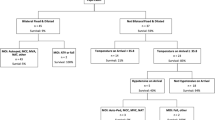Abstract
Purposes
This study aimed to clarify the prognosis of polytrauma patients presenting to the emergency department (ED) with a Glasgow Coma Scale score (GCS) of 3.
Methods
A trauma registry system has been established at our institution since 2009. The current study reviewed patients in the registry who presented to the ED with a GCS of 3 from January 2011 to December 2015. Surviving and non-surviving patients were compared to identify the prognostic factors of patient survival. The study also aimed to determine the factors contributing to patients who survived with a GCS > 13 at discharge.
Results
During the study period, 145 patients were enrolled in the study, 119 of whom (82.1%) did not survive the traumatic insult. Of the 26 survivors, 13 (9.0%) had a GCS of 14 or 15 at discharge. The multiple logistic regression revealed that a lack of bilateral dilated and fixed pupils (BFDP) (OR 5.967, 95% CI 1.780–19.997, p = 0.004) and a GCS > 3 after resuscitation (OR 6.875, 95% CI 2.135–22.138, p = 0.001) were independent prognostic factors of survival. Based on the multiple logistic regression, an age under 40 years (OR 16.405, 95% CI 1.520–177.066, p = 0.021) and a GCS > 3 after resuscitation (OR 12.100, 95% CI 1.058–138.352, p = 0.045) were independent prognostic factors of a GCS > 13 at discharge.
Conclusion
Aggressive resuscitation still provided benefit to polytrauma patients presenting with a GCS of 3, especially those with a rapid response to the resuscitation. Young patients with a deep coma on arrival had a higher probability of functional recovery after resuscitation in the ED.
Similar content being viewed by others
References
Lieberman JD, Pasquale MD, Garcia R, Cipolle MD, Mark Li P, Wasser TE. Use of admission Glasgow Coma Score, pupil size, and pupil reactivity to determine outcome for trauma patients. The Journal of trauma. 2003;55(3):437–42. https://doi.org/10.1097/01.TA.0000081882.79587.17 (discussion 42–3).
Tien HC, Cunha JR, Wu SN, Chughtai T, Tremblay LN, Brenneman FD, et al. Do trauma patients with a Glasgow Coma Scale score of 3 and bilateral fixed and dilated pupils have any chance of survival? J Trauma. 2006;60(2):274–8. https://doi.org/10.1097/01.ta.0000197177.13379.f4.
Mauritz W, Leitgeb J, Wilbacher I, Majdan M, Janciak I, Brazinova A, et al. Outcome of brain trauma patients who have a Glasgow Coma Scale score of 3 and bilateral fixed and dilated pupils in the field. Eur J Emerg Med. 2009;16(3):153–8. https://doi.org/10.1097/MEJ.0b013e32832a0864.
Nijboer JM, van der Naalt J, ten Duis HJ. Patients beyond salvation? Various categories of trauma patients with a minimal Glasgow Coma Score. Injury. 2010;41(1):52 – 7. https://doi.org/10.1016/j.injury.2009.05.030.
Pickett W, Ardern C, Brison RJ. A population-based study of potential brain injuries requiring emergency care. CMAJ: Canadian Medical Association journal = journal de l’Association medicale canadienne. 2001;165(3):288–92.
Demetriades D, Kuncir E, Velmahos GC, Rhee P, Alo K, Chan LS. Outcome and prognostic factors in head injuries with an admission Glasgow Coma Scale score of 3. Arch Surg. 2004;139(10):1066–8. https://doi.org/10.1001/archsurg.139.10.1066.
Chamoun RB, Robertson CS, Gopinath SP. Outcome in patients with blunt head trauma and a Glasgow Coma Scale score of 3 at presentation. J Neurosurg. 2009;111(4):683–7. https://doi.org/10.3171/2009.2.JNS08817.
Maas AI, Hukkelhoven CW, Marshall LF, Steyerberg EW. Prediction of outcome in traumatic brain injury with computed tomographic characteristics: a comparison between the computed tomographic classification and combinations of computed tomographic predictors. Neurosurgery. 2005;57(6):1173–82 (discussion—82).
Waxman K, Sundine MJ, Young RF. Is early prediction of outcome in severe head injury possible? Arch Surg. 1991;126(10):1237–41 (discussion 42).
Pal J, Brown R, Fleiszer D. The value of the Glasgow Coma Scale and Injury Severity Score: predicting outcome in multiple trauma patients with head injury. J Trauma. 1989;29(6):746–8.
Chaudhuri K, Malham GM, Rosenfeld JV. Survival of trauma patients with coma and bilateral fixed dilated pupils. Injury. 2009;40(1):28–32. https://doi.org/10.1016/j.injury.2008.09.004.
Jain S, Dharap SB, Gore MA. Early prediction of outcome in very severe closed head injury. Injury. 2008;39(5):598–603. https://doi.org/10.1016/j.injury.2007.06.003.
Choi SC, Muizelaar JP, Barnes TY, Marmarou A, Brooks DM, Young HF. Prediction tree for severely head-injured patients. J Neurosurg. 1991;75(2):251–5. https://doi.org/10.3171/jns.1991.75.2.0251.
Hoffmann M, Lefering R, Rueger JM, Kolb JP, Izbicki JR, Ruecker AH, et al. Pupil evaluation in addition to Glasgow Coma Scale components in prediction of traumatic brain injury and mortality. Br J Surg. 2012;99(Suppl 1):122–30. https://doi.org/10.1002/bjs.7707.
Quigley MR, Vidovich D, Cantella D, Wilberger JE, Maroon JC, Diamond D. Defining the limits of survivorship after very severe head injury. J Trauma. 1997;42(1):7–10.
Author information
Authors and Affiliations
Corresponding author
Ethics declarations
Conflict of interest
All authors declare that they have no conflict of interest.
Ethics approval and consent to participate
The current study was approved by Chang Gung Medical Foundation Institutional Review Broad with the reference No. 201700733B0.
Rights and permissions
About this article
Cite this article
Huang, JF., Ou Yang, CH., Fu, CY. et al. Deep coma does not always predict poor outcomes among patients with polytrauma. Eur J Trauma Emerg Surg 45, 455–460 (2019). https://doi.org/10.1007/s00068-018-0917-8
Received:
Accepted:
Published:
Issue Date:
DOI: https://doi.org/10.1007/s00068-018-0917-8




